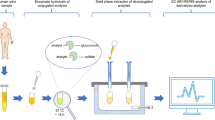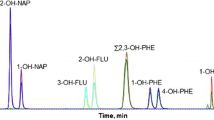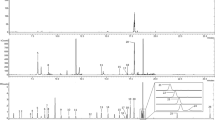Abstract
A gas chromatographic-tandem mass spectrometric (GC-MS/MS) method for the simultaneous determination of the three well-known endocrine disruptors, bisphenol A, daidzein and genistein, as well as of four human pesticide metabolites which are supposed to have proper endocrine activity or which are metabolites of endocrine-disrupting compounds, viz., 1- and 2-naphthol, 2-isopropoxyphenol and 3,5,6-trichloropyridinol, has been developed and validated. The method involves enzymatic cleavage of the conjugates using β-glucuronidase/arylsulfatase followed by solid-phase extraction and derivatisation with N-tert-butyldimethylsilyl-N-methyltrifluoroacetamide. Isotopically labelled internal standards were used for all analytes, to achieve best analytical error correction. The method proved to be both sensitive and reliable in human urine with detection limits ranging from 0.1 to 0.6 μg/L for all analytes. Precision and repeatability was determined to range from 1 to 15 %. Compared with other published analytical procedures, the present method enables the simultaneous determination of a couple of phenolic agents with competitive or improved analytical reliability. Thus, the present method is suitable for a combined monitoring of the exposure to prominent xenobiotics with effects on the human endocrine system (bisphenol A, carbaryl, chlorpyrifos, chlorpyrifos-methyl, naphthalene, propoxur, triclopyr) and phytoestrogens (daidzein, genistein) in population studies.





Similar content being viewed by others
References
Hu JY, Aizawa T (2003) Quantitative structure-activity relationships for estrogen receptor binding affinity of phenolic chemicals. Water Res 37(6):1213–1222
National Toxicology Programme, Center for the Evaluation of Risks to Human Reproduction, U.S. Department of Health and Human Services Food and Drug Administration F (2008) Monograph on the potential human reproductive and developmental effect of bisphenol A. NIH Publication No. 08-5994
European Food Safety Authority, EFSA Panel (2007) Opinion of the Scientific Panel on food additives, flavourings, processing aids and materials in contact with food (AFC) related to 2,2-bis(4-hydroxyphenyl)propane (bisphenol A). EFSA J 428:1–75. doi:10.2903/j.efsa.2007.428
Kortenkamp A (2007) Ten years of mixing cocktails: a review of combination effects of endocrine-disrupting chemicals. Environ Health Perspect 115:98–105. doi:10.1289/ehp.9357
Dekant W, Völkel W (2008) Human exposure to bisphenol A by biomonitoring: methods, results and assessment of environmental exposures. Toxicol Appl Pharmacol 228(1):114–134
Völkel W, Kiranoglu M, Fromme H (2008) Determination of free and total bisphenol A in human urine to assess daily uptake as a basis for a valid risk assessment. Toxicol Lett 179(3):155–162. doi:10.1016/j.toxlet.2008.05.002
Ejaz S, Akram W, Lim CW, Lee JJ, Hussain I (2004) Endocrine disrupting pesticides: a leading cause of cancer among rural people in Pakistan. Exp Oncol 26(2):98–105
Gore AC (2001) Environmental toxicant effects on neuroendocrine function. Endocrine 14(2):235–246
Racke KD (1993) Environmental fate of chlorpyrifos. Rev Environ Contam Toxicol 131:1
Nolan R, Rick D, Freshour N, Saunders J (1984) Chlorpyrifos: pharmacokinetics in human volunteers. Toxicol Appl Pharmacol 73(1):8–15
Carmichael N, Nolan R, Perkins J, Davies R, Warrington S (1989) Oral and dermal pharmacokinetics of triclopyr in human volunteers. Hum Exp Toxicol 8(6):431
Hardt J, Angerer J (1999) Gas chromatographic method with mass-selective detection for the determination of 2-isopropoxyphenol in human urine. J Chromatogr B 723(1–2):139–145
Leenheers LH, van Breugel DC, Ravensberg JC, Meuling WJA, Jongen MJM (1992) Determination of 2-isopropoxyphenol in urine by capillary gas chromatography and mass-selective detection. J Chromatogr B 578(2):189–194. doi:10.1016/0378-4347(92)80415-m
Krechniak J, Foss W (1979) Determination of propoxur and 2-isopropoxyphenol in blood, urine and tissues. Bull Environ Contam Toxicol 23(1):531–535. doi:10.1007/bf01769999
Klotz DM, Arnold SF, McLachlan JA (1997) Inhibition of 17 beta-estradiol and progesterone activity in human breast and endometrial cancer cells by carbamate insecticides. Life Sci 60(17):1467–1475. doi:10.1016/s0024-3205(97)00098-2
Meeker JD, Barr DB, Serdar B, Rappaport SM, Hauser R (2006) Utility of urinary 1-naphthol and 2-naphthol levels to assess environmental carbaryl and naphthalene exposure in an epidemiology study. J Expo Sci Environ Epidemiol 17(4):314–320
Sun H, Shen OX, Xu XL, Song L, Wang XR (2008) Carbaryl, 1-naphthol and 2-naphthol inhibit the beta-1 thyroid hormone receptor-mediated transcription in vitro. Toxicology 249(2–3):238–242. doi:10.1016/j.tox.2008.05.008
Meeker JD, Ryan L, Barr DB, Herrick RF, Bennett DH, Bravo R, Hauser R (2004) The relationship of urinary metabolites of carbaryl/naphthalene and chlorpyrifos with human semen quality. Environ Health Perspect 112(17):1665–1670. doi:10.1289/ehp.7234
Clarke DB, Lloyd AS, Botting NP, Oldfield MF, Needs PW, Wiseman H (2002) Measurement of intact sulfate and glucuronide phytoestrogen conjugates in human urine using isotope dilution liquid chromatography-tandem mass spectrometry with [13C3] isoflavone internal standards. Anal Biochem 309(1):158–172
Taku K, Umegaki K, Ishimi Y, Watanabe S (2008) Effects of extracted soy isoflavones alone on blood total and LDL cholesterol: meta-analysis of randomized controlled trials. Ther Clin Risk Manag 4(5):1097–1103
Siow RCM, Mann GE (2010) Dietary isoflavones and vascular protection: activation of cellular antioxidant defenses by SERMs or hormesis? Mol Aspects Med 31(6):468–477
Taku K, Melby MK, Nishi N, Omori T, Kurzer MS (2011) Soy isoflavones for osteoporosis: an evidence-based approach. Maturitas 70(4):333–338. doi:10.1016/j.maturitas.2011.09.001
Fraser LR, Beyret E, Milligan SR, Adeoya-Osiguwa SA (2006) Effects of estrogenic xenobiotics on human and mouse spermatozoa. Hum Reprod 21(5):1184–1193. doi:10.1093/humrep/dei486
Chavarro JE, Toth TL, Sadio SM, Hauser R (2008) Soy food and isoflavone intake in relation to semen quality parameters among men from an infertility clinic. Hum Reprod 23(11):2584–2590. doi:10.1093/humrep/den243
Mitchell JH, Cawood E, Kinniburgh D, Provan A, Collins AR, Irvine DS (2001) Effect of a phytoestrogen food supplement on reproductive health in normal males. Clin Sci 100(6):613–618
Song G, Kochman L, Andolina E, Herko RC, Brewer KJ, Lewis V (2006) Beneficial effects of dietary intake of plant phytoestrogens on semen parameters and sperm DNA integrity in infertile men. Fertil Steril 86(3):S49
Messina M (2011) Evidence does not support the conclusion that soy is an endocrine disruptor. J Pediatr Endocrinol Metab 24(9–10):859–860
Bar-El Dadon S, Reifen R (2010) Soy as an endocrine disruptor: cause for caution? J Pediatr Endocrinol Metab 23(9):855–861
Andres S, Abraham K, Appel KE, Lampen A (2011) Risks and benefits of dietary isoflavones for cancer. Crit Rev Toxicol 41(6):463–506
Gray L, Wilson VS, Stoker T, Lambright C, Furr J, Noriega N, Howdeshell K, Ankley GT, Guillette L (2006) Adverse effects of environmental antiandrogens and androgens on reproductive development in mammals1. Int J Androl 29(1):96–104. doi:10.1111/j.1365-2605.2005.00636.x
Kortenkamp A (2008) Low dose mixture effects of endocrine disrupters: implications for risk assessment and epidemiology. Int J Androl 31(2):233–240. doi:10.1111/j.1365-2605.2007.00862.x
DIN 32645 (2008) Chemical analysis—decision limit, detection limit and determination limit under repeatability conditions—terms, methods, evaluation. Beuth, Berlin
Bartels MJ, Kastl PE (1992) Analysis of 3,5,6-trichloropyridinol in human urine using negative-ion chemical ionization gas chromatography–mass spectrometry. J Chromatogr B Biomed Sci Appl 575(1):69–74. doi:10.1016/0378-4347(92)80505-k
Xu J, Wu L, Chen W, Chang AC (2008) Simultaneous determination of pharmaceuticals, endocrine disrupting compounds and hormone in soils by gas chromatography–mass spectrometry. J Chromatogr A 1202(2):189–195
Moors S, Blaszkewicz M, Bolt HM, Degen GH (2007) Simultaneous determination of daidzein, equol, genistein and bisphenol A in human urine by a fast and simple method using SPE and GC-MS. Mol Nutr Food Res 51(7):787–798
Bravo R, Caltabiano LM, Fernandez C, Smith KD, Gallegos M, Whitehead RD Jr, Weerasekera G, Restrepo P, Bishop AM, Perez JJ, Needham LL, Barr DB (2005) Quantification of phenolic metabolites of environmental chemicals in human urine using gas chromatography–tandem mass spectrometry and isotope dilution quantification. J Chromatogr B 820(2):229–236. doi:10.1016/j.jchromb.2005.03.012
Krauss D, Mainx HG, Tauscher B, Bischof P (1985) Fragmentation of trimethylsilyl derivatives of 2-alkoxyphenols: a further violation of the ‘even-electron rule’. Org Mass Spectrom 20(10):614–618. doi:10.1002/oms.1210201005
Koch HM, Kolossa-Gehring M, Schröter-Kermani C, Angerer J, Brüning T (2012) Bisphenol A in 24 h urine and plasma samples of the German Environmental Specimen Bank from 1995 to 2009: a retrospective exposure evaluation. J Expo Sci Environ Epidemiol 22:610–616. doi:10.1038/jes.2012.39
Koch HM, Angerer J (2001) Analysis of 3,5,6-trichloro-2-pyridinol in urine samples from the general population using gas chromatography–mass spectrometry after steam distillation and solid-phase extraction. J Chromatogr B Biomed Sci Appl 759(1):43–49. doi:10.1016/s0378-4347(01)00209-2
Ye X, Kuklenyik Z, Needham LL, Calafat AM (2005) Automated on-line column-switching HPLC-MS/MS method with peak focusing for the determination of nine environmental phenols in urine. Anal Chem 77(16):5407–5413
Arakawa C, Fujimaki K, Yoshinaga J, Imai H, Serizawa S, Shiraishi H (2004) Daily urinary excretion of bisphenol A. Environ Health Prev Med 9(1):22–26
Grace PB, Taylor JI, Botting NP, Fryatt T, Oldfield MF, Bingham SA (2003) Quantification of isoflavones and lignans in urine using gas chromatography/mass spectrometry. Anal Biochem 315(1):114–121
Campo L, Rossella F, Fustinoni S (2008) Development of a gas chromatography/mass spectrometry method to quantify several urinary monohydroxy metabolites of polycyclic aromatic hydrocarbons in occupationally exposed subjects. J Chromatogr B 875(2):531–540
Yoshida T, Yoshida J (2012) Simultaneous analytical method for urinary metabolites of organophosphorus compounds and moth repellents in general population. J Chromatogr B 880:66–73
Author information
Authors and Affiliations
Corresponding author
Electronic supplementary material
Below is the link to the electronic supplementary material.
ESM 1
(PDF 578 kb)
Rights and permissions
About this article
Cite this article
Schmidt, L., Müller, J. & Göen, T. Simultaneous monitoring of seven phenolic metabolites of endocrine disrupting compounds (EDC) in human urine using gas chromatography with tandem mass spectrometry. Anal Bioanal Chem 405, 2019–2029 (2013). https://doi.org/10.1007/s00216-012-6618-y
Received:
Revised:
Accepted:
Published:
Issue Date:
DOI: https://doi.org/10.1007/s00216-012-6618-y




